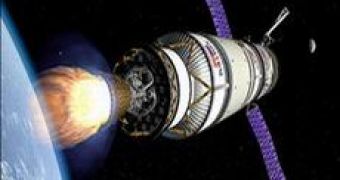There are only 7 days left until the shuttle Discovery will fire up its booster rockets and embark on a mission that is as risky as it is vital for the future of space exploration. We've talked about the CAIB safety recommendations and about the fact that the most important three of them haven't been met over and over again for the past few weeks. And that is why in this article we'll do something quite different. We'll focus on the future options NASA is considering for continuing its manned space flight program.
According to President Bush's vision for long-term robotic and human space exploration, NASA will stop flying the three remaining shuttle orbiters by 2010, return to the moon in a different spacecraft by 2020 and prepare for eventual flights to Mars
This sounds as a pretty good plan. Except for one "minor" detail. We're in mid-2005, so less than 5 years away from the moment the current shuttles will be decommissioned, and there's no idea of how the future CEV (Crew Exploration Vehicle) will look like. It's not even sure who's going to build it.
NASA has actually selected its largest industrial partners, one team headed by Lockheed Martin and the second by Northrop Grumman and Boeing, to compete for an award to design and build the CEV. The space agency is expected to direct one of the two companies to begin building its design as early as 2006.
This is not the NASA's first attempt at building a replacement for the already old orbiters. The agency intended to build a small fleet of reusable vehicles that could be launched as often as every two weeks for about $35 million per liftoff. But they haven't even gotten close, because, even before Columbia's accident, the shuttle was averaging only five flights a year, at a cost of almost $500 million each.
NASA has tried over the past decade to come up with a workable design, but, unfortunately, it failed. The plans for the X-33, X-34, X-37, X-38 and Orbital Space Plane were all abandoned, some because of congressional reluctance to provide funding.
But, seeing that this new orbiter will be built on such a short notice, won't it have serious technical and safety-related problems? According to Kim Cobb for the Houston Chronicle, former astronaut and outspoken crew safety advocate Robert "Hoot" Gibson worries about shortcuts and compromises as NASA rushes toward the deadlines.
"Yes, I do. I do feel there's some concern about that," Gibson said. "And frankly, I don't see how we're going to get from point A to point B - to get from here to, say, 2015 and theoretically by that point we've retired the space shuttle and are operating in space with a whole new vehicle."

 14 DAY TRIAL //
14 DAY TRIAL //